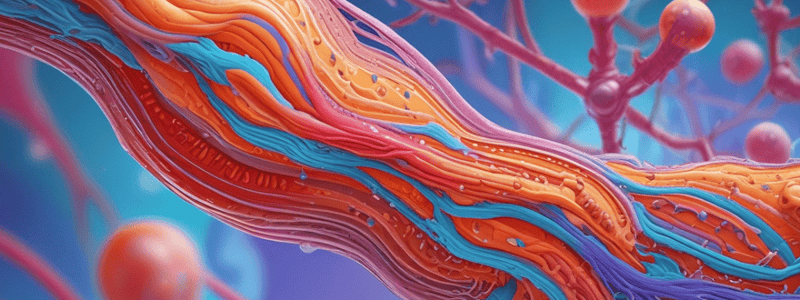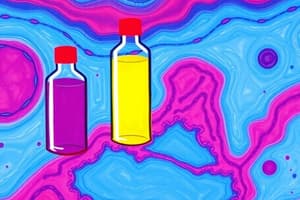Podcast
Questions and Answers
What is the primary objective of tissue fixation?
What is the primary objective of tissue fixation?
- To preserve the chemical composition of the sample
- To preserve the cells and tissue components as close to normal as possible (correct)
- To increase the mechanical strength of the sample
- To prevent extrinsic damage to the sample
How does fixative typically protect a sample from damage?
How does fixative typically protect a sample from damage?
- By altering the cells or tissues on a molecular level
- By killing any microorganisms that may be present in the sample
- By increasing the mechanical stability of the sample
- By disabling intrinsic biomolecules that would otherwise damage the sample (correct)
What is the purpose of the additional processing steps and final analyses that are planned?
What is the purpose of the additional processing steps and final analyses that are planned?
- To further preserve the morphology of the sample
- To increase the mechanical strength of the sample
- To chemically mask the protein targets for immunohistochemistry
- To determine the appropriate fixation method to use (correct)
How does heat fixation differ from other fixation methods?
How does heat fixation differ from other fixation methods?
What is the effect of prolonged fixation on immunohistochemistry analysis?
What is the effect of prolonged fixation on immunohistochemistry analysis?
What is the purpose of mixing the sample with water or physiological saline in heat fixation?
What is the purpose of mixing the sample with water or physiological saline in heat fixation?
Which of the following is the most common staining technique used in routine histological analysis?
Which of the following is the most common staining technique used in routine histological analysis?
What is the primary function of the counterstain in a staining procedure?
What is the primary function of the counterstain in a staining procedure?
Which of the following is a characteristic of the Leishman stain?
Which of the following is a characteristic of the Leishman stain?
What is the primary purpose of staining biological tissues for microscopic examination?
What is the primary purpose of staining biological tissues for microscopic examination?
Which of the following factors can influence the intensity of staining in a tissue section?
Which of the following factors can influence the intensity of staining in a tissue section?
Which of the following is a characteristic of an artifact in a microscopic tissue preparation?
Which of the following is a characteristic of an artifact in a microscopic tissue preparation?
Which of the following is a primary component of the Leishman stain?
Which of the following is a primary component of the Leishman stain?
What is the primary function of the fixative used in tissue preparation?
What is the primary function of the fixative used in tissue preparation?
Which of the following is a characteristic of natural dyes used in tissue staining?
Which of the following is a characteristic of natural dyes used in tissue staining?
What is the primary purpose of using a counterstain in a tissue preparation?
What is the primary purpose of using a counterstain in a tissue preparation?
What is the primary purpose of the fixation process in tissue preparation?
What is the primary purpose of the fixation process in tissue preparation?
Which factor is least important in determining the effectiveness of chemical fixation?
Which factor is least important in determining the effectiveness of chemical fixation?
What is the purpose of the clearing step in tissue processing?
What is the purpose of the clearing step in tissue processing?
Which of the following statements is true regarding the embedding process in tissue preparation?
Which of the following statements is true regarding the embedding process in tissue preparation?
What is the typical thickness range of tissue sections cut for transmission electron microscopy?
What is the typical thickness range of tissue sections cut for transmission electron microscopy?
Which of the following statements is true regarding the mounting of tissue sections?
Which of the following statements is true regarding the mounting of tissue sections?
What is the primary advantage of using the freezing method for tissue fixation?
What is the primary advantage of using the freezing method for tissue fixation?
Which of the following statements is true regarding the duration of chemical fixation?
Which of the following statements is true regarding the duration of chemical fixation?
What is the purpose of the dehydration step in tissue processing?
What is the purpose of the dehydration step in tissue processing?
Which of the following factors should be considered when selecting the embedding medium for tissue preparation?
Which of the following factors should be considered when selecting the embedding medium for tissue preparation?
Fixation is the final step in the process to prepare a sample of biological material for microscopy analysis.
Fixation is the final step in the process to prepare a sample of biological material for microscopy analysis.
Fixatives are non-toxic to common microorganisms like bacteria.
Fixatives are non-toxic to common microorganisms like bacteria.
The purpose of fixation is solely to increase the mechanical strength of cells and tissues.
The purpose of fixation is solely to increase the mechanical strength of cells and tissues.
Heat fixation is commonly used for multicellular organisms like plants.
Heat fixation is commonly used for multicellular organisms like plants.
Quick fix using cold formalin for around 24 hours is primarily used in immunohistochemistry to enhance antibody binding.
Quick fix using cold formalin for around 24 hours is primarily used in immunohistochemistry to enhance antibody binding.
Fixatives do not alter cells or tissues at a molecular level.
Fixatives do not alter cells or tissues at a molecular level.
Leishman stain is mainly used for staining DNA in the cell nucleus.
Leishman stain is mainly used for staining DNA in the cell nucleus.
Acidic dyes bind with negatively charged basophilic tissue.
Acidic dyes bind with negatively charged basophilic tissue.
Hematoxylin stains RNA-rich portions of the cytoplasm pink.
Hematoxylin stains RNA-rich portions of the cytoplasm pink.
The nuclei take up a pink stain with Leishman stain.
The nuclei take up a pink stain with Leishman stain.
Eosin is considered a primary dye in H&E staining.
Eosin is considered a primary dye in H&E staining.
Neutral dyes are commonly extracted from plants and animals.
Neutral dyes are commonly extracted from plants and animals.
Chelating dyes are used based on tissue geometry.
Chelating dyes are used based on tissue geometry.
Artifacts can occur due to extraneous factors before fixation only.
Artifacts can occur due to extraneous factors before fixation only.
Natural dyes are mostly petroleum derivatives.
Natural dyes are mostly petroleum derivatives.
Heat fixation is typically used in routine histological analysis.
Heat fixation is typically used in routine histological analysis.
In tissue processing, dehydration removes all water from the tissue by using diluted alcohol solutions.
In tissue processing, dehydration removes all water from the tissue by using diluted alcohol solutions.
The pH for ultrastructure preservation during fixation should be buffered between 7.2 to 7.4.
The pH for ultrastructure preservation during fixation should be buffered between 7.2 to 7.4.
Hypertonic fixatives result in cell swelling and poor fixation.
Hypertonic fixatives result in cell swelling and poor fixation.
Embedding for electron microscopy commonly uses paraffin wax as the embedding medium.
Embedding for electron microscopy commonly uses paraffin wax as the embedding medium.
The thickness of tissue sections cut for light microscopy using a steel knife is typically 5-10 µm.
The thickness of tissue sections cut for light microscopy using a steel knife is typically 5-10 µm.
Tissue freezing is a method that provides fine details but does not give rapid results.
Tissue freezing is a method that provides fine details but does not give rapid results.
An ideal thickness for tissue specimens during fixation is between 1-4 cm.
An ideal thickness for tissue specimens during fixation is between 1-4 cm.
Embedding for electron microscopy involves using molds to harden the tissue samples.
Embedding for electron microscopy involves using molds to harden the tissue samples.
Chemical fixation occurs within milliseconds and allows preservation of structures in their native state.
Chemical fixation occurs within milliseconds and allows preservation of structures in their native state.
FFPE tissues can only be stored at low temperatures to prevent degradation.
FFPE tissues can only be stored at low temperatures to prevent degradation.
Flashcards are hidden until you start studying




